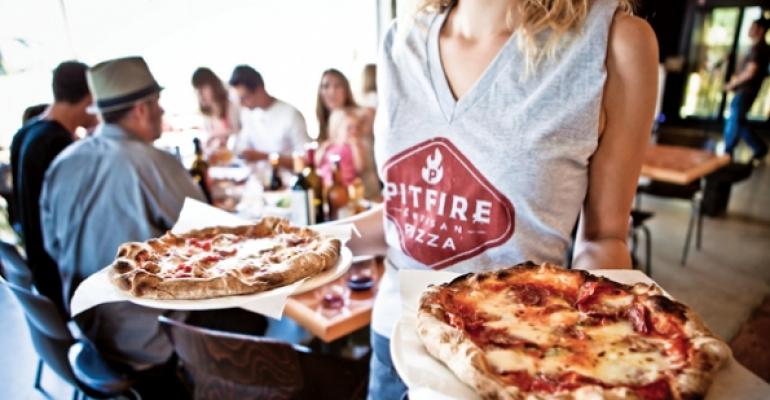This will be the year Pitfire Artisan Pizza proves that a “cool brand” that works in Los Angeles will also work elsewhere.
![]()
So maintains Paul Hibler, co-founder of the fast-casual pizza concept, which has five units in Los Angeles that average about $3 million in sales. In December a sixth restaurant opened in Costa Mesa, Calif., and No. 7 was scheduled to open in Manhattan Beach, Calif., this month.
Hoping to get at least four more units open in 2013, Hibler said the concept may make the jump into the San Francisco market late in the year.
The Costa Mesa unit could be a game changer. There, Hibler has tweaked the concept somewhat, moving into a 5,600-square-foot freestanding space. Other units are around 3,500 to 4,000 square feet.
The Costa Mesa store has three components. A main dining room serves the chain’s wood-fired pizzas, pastas, salads and paninis. A middle section holds what Hibler called the “community kitchen,” which can host events, cooking classes or private parties. In the back is Pie Society, a “speakeasy” with a separate entrance and a full bar. It also serves as overflow seating for the restaurant.
The bar is an experiment that may be applied to other locations, if it fits. Currently, most Pitfire units offer beer and wine.
The goal, said Hibler, is to create a space where groups can gather, linger and interact.
![]()
“We’re sort of reinventing what a pizza parlor is,” he said. “People have really responded to the fact that we created such a space for the community.”
The community kitchen also serves as a dough-making facility for other locations. Pitfire’s dough is made fresh in house and is fermented to heighten the flavor of the crust.
Sauces and dressings are made in a commissary in Los Angeles and delivered to the units. Hibler is passionate about offering a truly artisanal product, without compromise.
“Other companies might outsource products, but I will never do that,” he said. “If it’s an artisan food company, we can’t give that lip service.”
Pitfire is known for unique pizzas based on seasonal ingredients. Tired, once-popular styles like barbecue chicken pizza have been pushed aside in favor of more exotic offerings, such as Brussels sprouts and bacon lardons with Parmesan cream; or roasted pears, house-made Burrata and escarole.
For dessert, there’s organic vanilla soft-serve ice cream with olive oil and maldon salt, house-made caramel sauce or chocolate.
![]()
Where some growing chains might go for a more slick, easily transferable brand image, Pitfire celebrates its eclectic, bohemian spirit as a truly L.A. concept — one where a tattooed, bike-riding hipster delivers daily heirloom tomatoes gathered from a farmers market, and the young and old, all pierced and multiethnic, gather to savor freshly prepared food. Guests order at the counter, and servers work the floor with mobile devices, bringing another drink or dessert. In some locations a DJ spins vinyl.
Delivery accounts for about 15 percent of sales as well.
Hibler, who described himself as more of a creative soul, recently brought in Carlos Bernal, a chain restaurant veteran and former president of Rice Garden Inc., as Pitfire’s chief executive.
“I’m the brand, and he’s the grown up. We fight all the time,” Hibler joked, noting that he needs someone with larger-company experience to handle infrastructure needs as the company grows.
The company also added a human resources director, an operations director and a marketing executive.
Jerry Prendergast, a restaurant consultant with Prendergast & Associates in Los Angeles, said Pitfire is riding a wave of popularity behind wood-fired pizza concepts, benefiting from improved oven equipment with pollution controls that have eased the permit process.
![]()
With an average transaction of about $22 — typically a shared meal — Pitfire’s price point is good for wood-fired pizza, Prendergast said.
The chain also has made smart real estate moves, going into secondary locations with lower costs per square foot.
“They’re not picking spaces they’re overpaying for,” he said.
So far, the chain has grown with private and self-funding, and Hibler has resisted offers from private equity and strategic partners.
“I still like doing it,” he said. “Those deals are predicated on [the notion] that you’re going to ramp up quick.”
And Hibler, for his part, prefers a slow, steady path. Doubling in size over the past year “hasn’t been pleasant,” he said.
Contact Lisa Jennings at [email protected].
Follow her on Twitter: @livetodineout.

